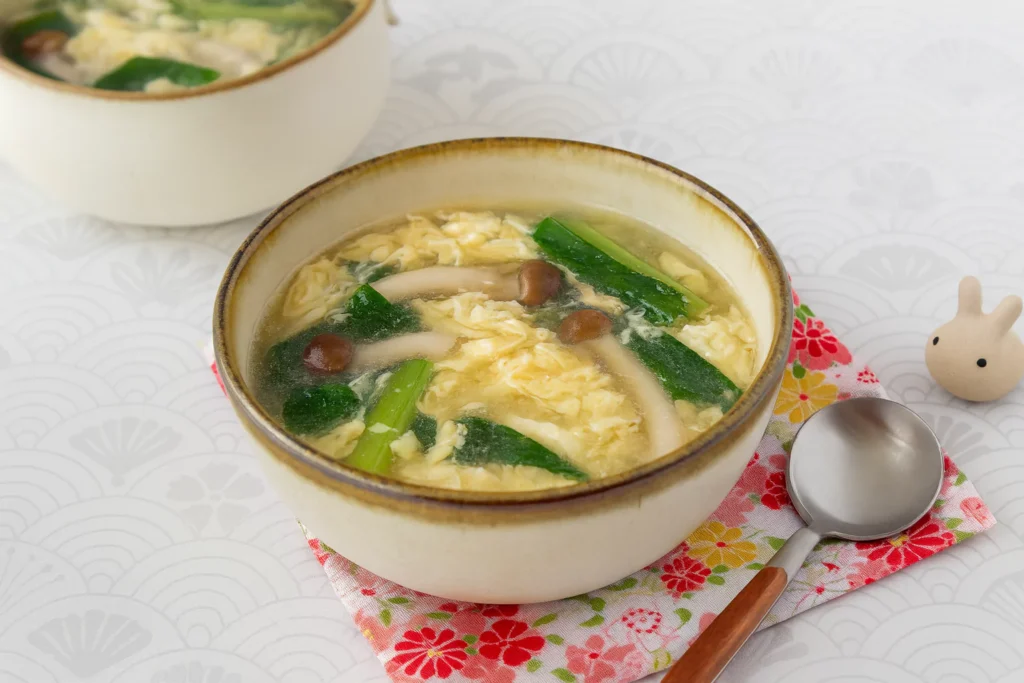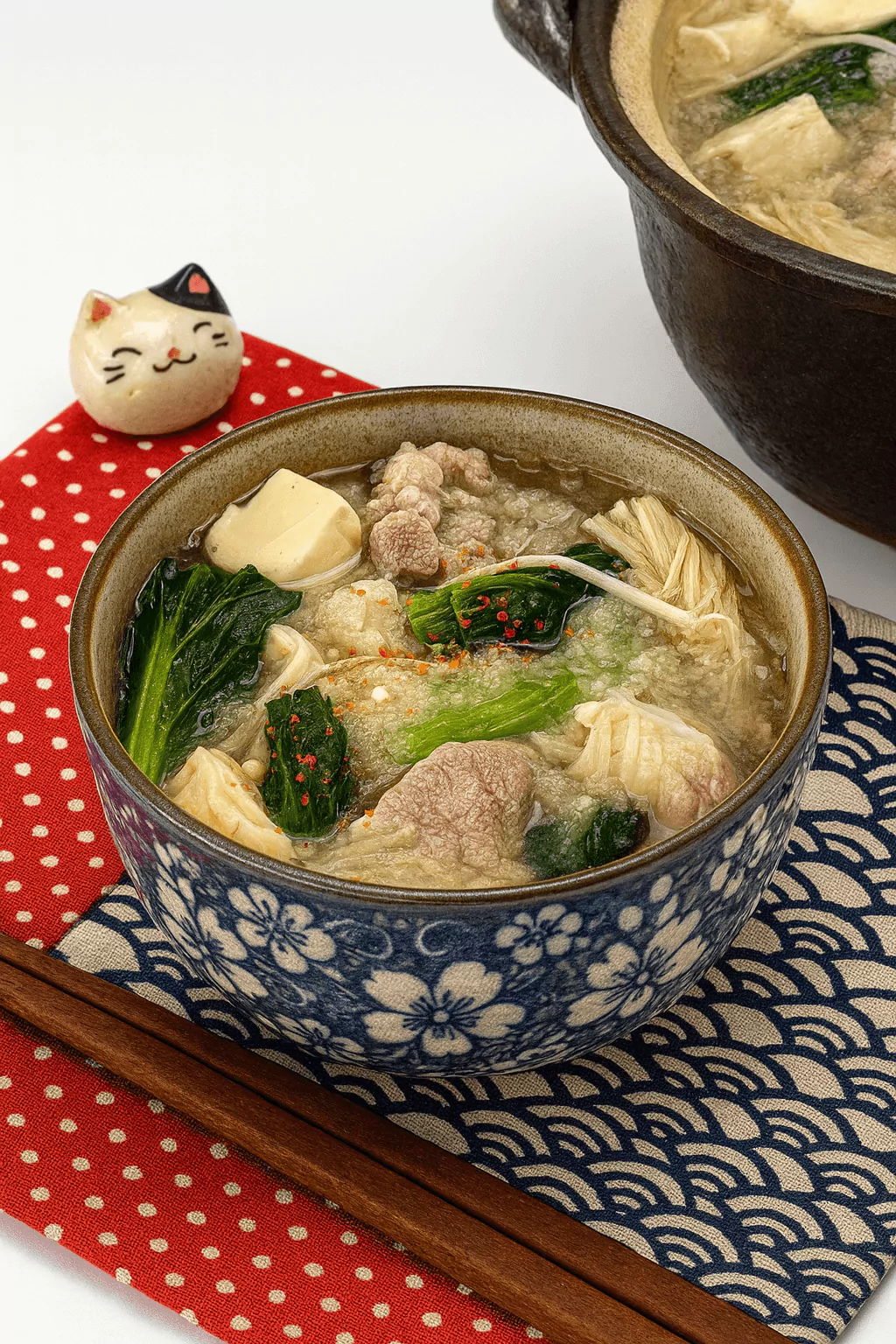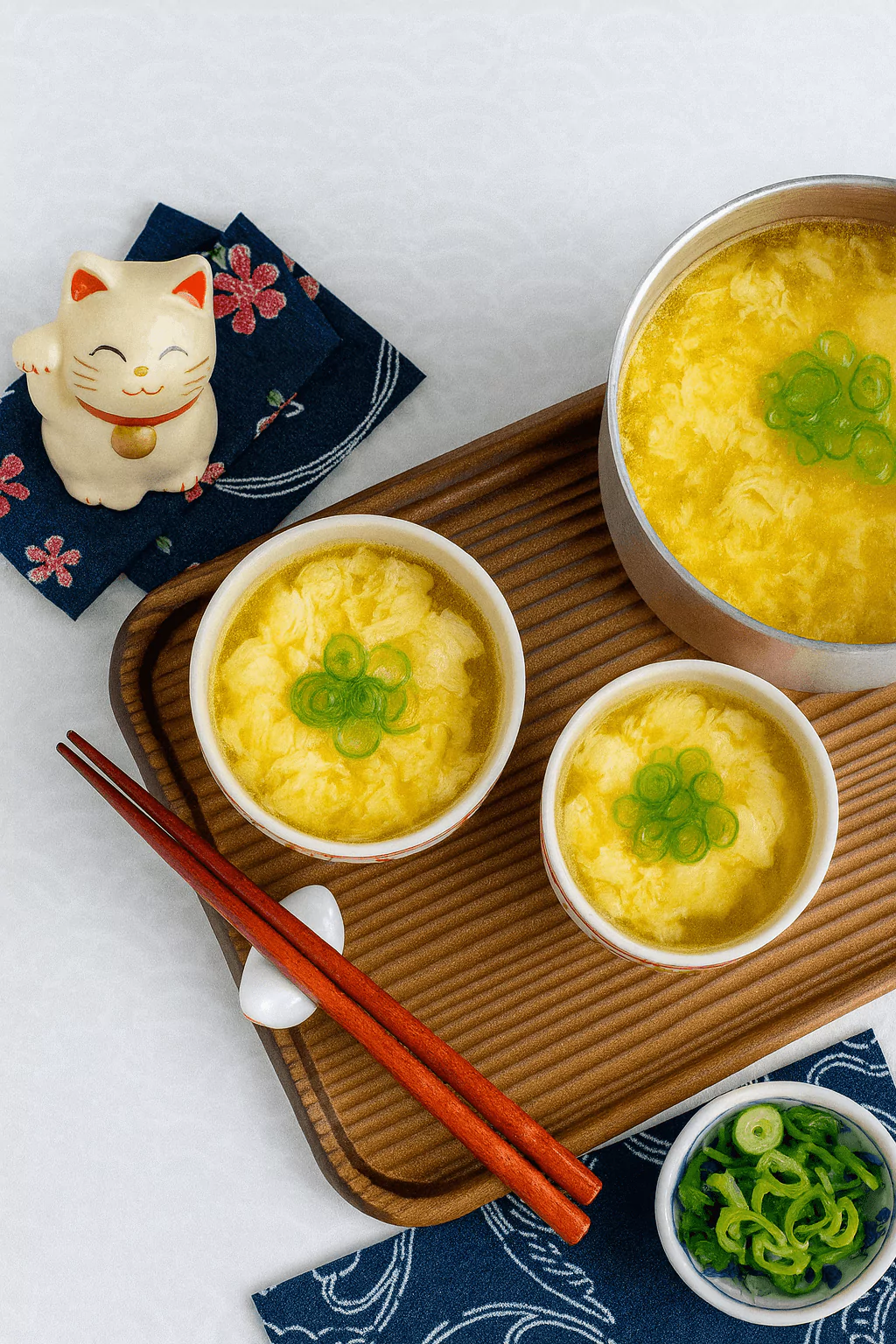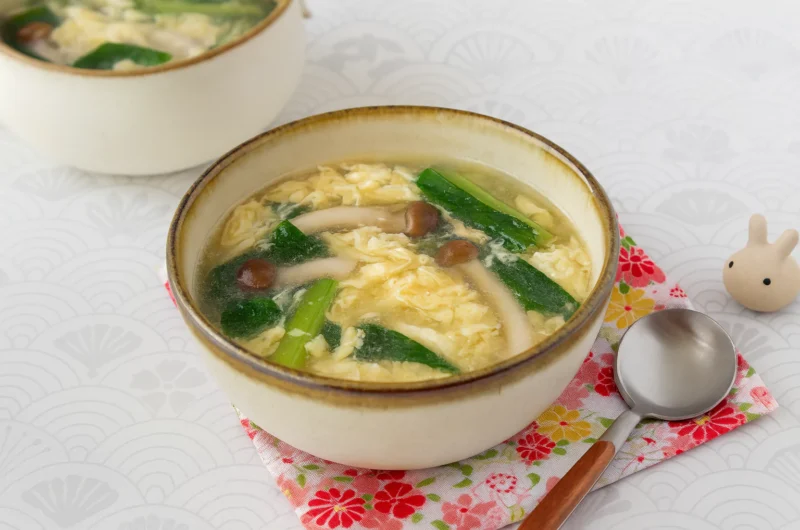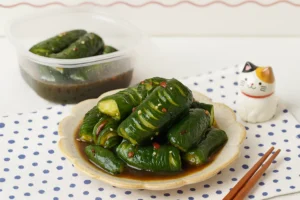Have you ever thought a simple bowl of soup could bring both comfort and powerful nutrition at the same time? Many people think soups are heavy or complicated, but Komatsuna soup (小松菜スープ) proves that a light, quick, and deeply nourishing dish can be made in just minutes. This Japanese favorite surprises first-timers with its gentle flavor, fluffy eggs, and the warming kick of ginger. If you’ve never tried it, you might wonder: how can such a simple recipe taste so comforting? By the end of this article, you’ll know the answer—and be ready to make it yourself at home.
Why Komatsuna Soup is Special
Komatsuna soup (小松菜スープ) is one of those recipes that checks all the boxes: quick, healthy, delicious, and easy to prepare. It takes about 15 minutes from start to finish, and the difficulty level is very low—even beginners can handle it without stress. Unlike soups that simmer for hours, this dish uses fresh greens, mushrooms, and a light dashi broth to create something soothing yet energizing. The fluffy beaten egg swirled in at the end makes the soup silky and filling.
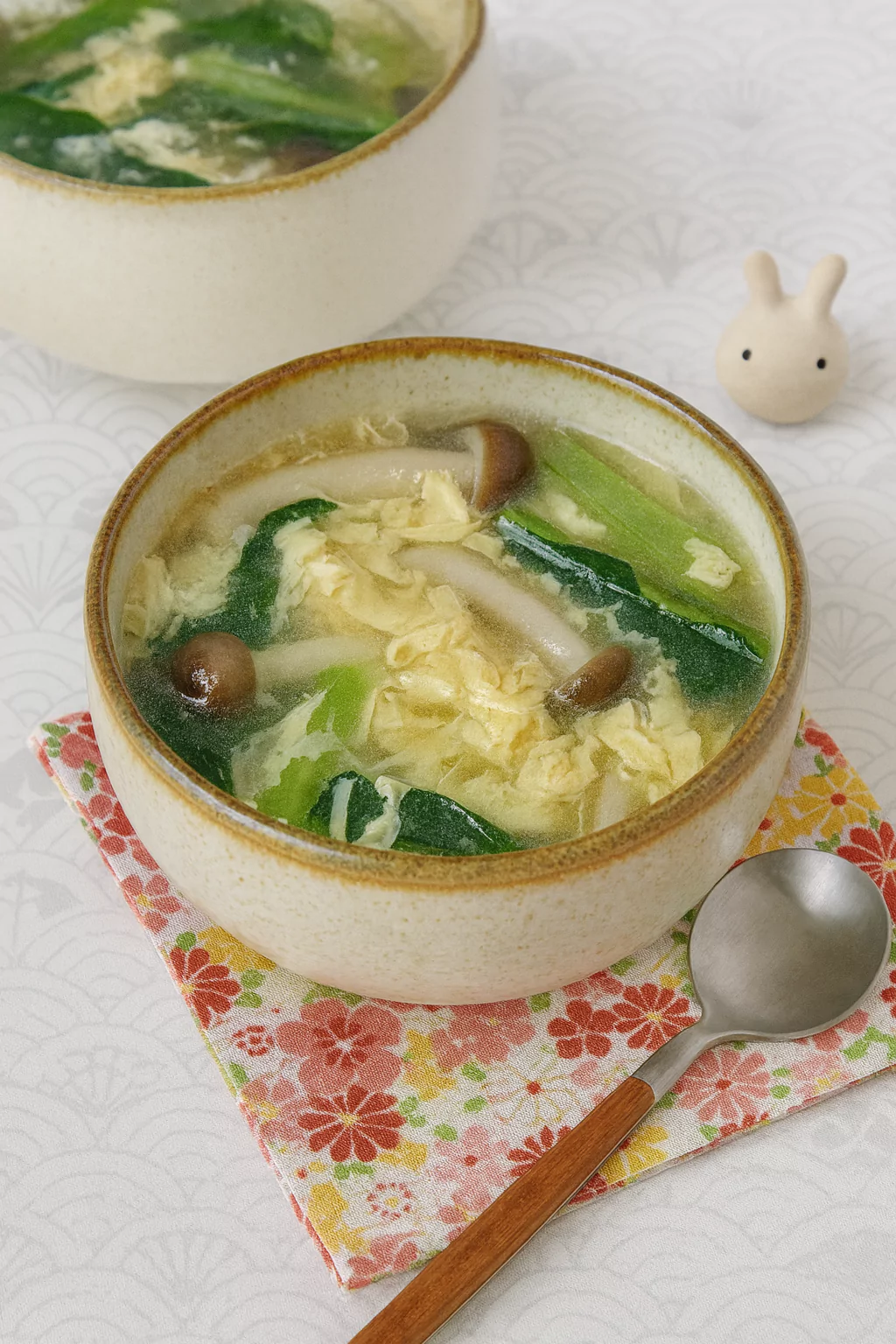
Komatsuna soup (小松菜スープ) @JapanDishes
What Is Komatsuna Soup (小松菜スープ)?
Komatsuna (小松菜) is a leafy Japanese green, also called Japanese mustard spinach. It belongs to the same family as bok choy and turnip greens. In this soup, the tender komatsuna leaves are combined with mushrooms, ginger, and egg in a dashi-based broth. The result is a dish that feels both homey and elegant. In Japan, this soup is often served at family tables, especially when someone needs warmth, lightness, and a boost of energy.
Essential Ingredients
Every ingredient in this soup has a role to play. Let’s take a closer look:
- Komatsuna (50 g / about ¼ bag)
The star of the dish. Komatsuna has a mild, slightly peppery taste, and it softens quickly when cooked. If you can’t find komatsuna, baby spinach or bok choy makes a good substitute. - Shimeji mushrooms (½ pack)
Shimeji add earthy flavor and texture. If unavailable, use enoki, shiitake, or even button mushrooms. - Ginger paste (4 cm from a tube)
Ginger brings warmth and a bit of spice. It’s also great for digestion. Fresh grated ginger works just as well. - Water (400 ml)
The base liquid for the broth. - White dashi (2 tablespoons)
A concentrated Japanese stock that adds umami. If you don’t have it, substitute with chicken or vegetable broth and a splash of soy sauce. - Pepper (a little)
For light seasoning. - Potato starch (2 teaspoons) mixed with water (1 tablespoon)
This creates a gentle thickening effect, giving the soup a smooth consistency. Cornstarch can also be used. - Egg (1 piece)
Beaten and added at the end, the egg transforms into soft ribbons in the hot broth, giving the soup body and comfort.
Optional substitutions and variations:
- Replace ginger with garlic for a different twist.
- Add tofu cubes for more protein.
- Sprinkle sesame seeds or drizzle sesame oil for a nutty finish.
Step-by-Step Instructions
Step 1: Prepare the Ingredients
- Wash the komatsuna thoroughly to remove any grit. Cut into pieces about 3 cm long.
- Trim off the root ends of the shimeji mushrooms and separate them into small clusters.
- Crack the egg into a bowl and beat lightly.
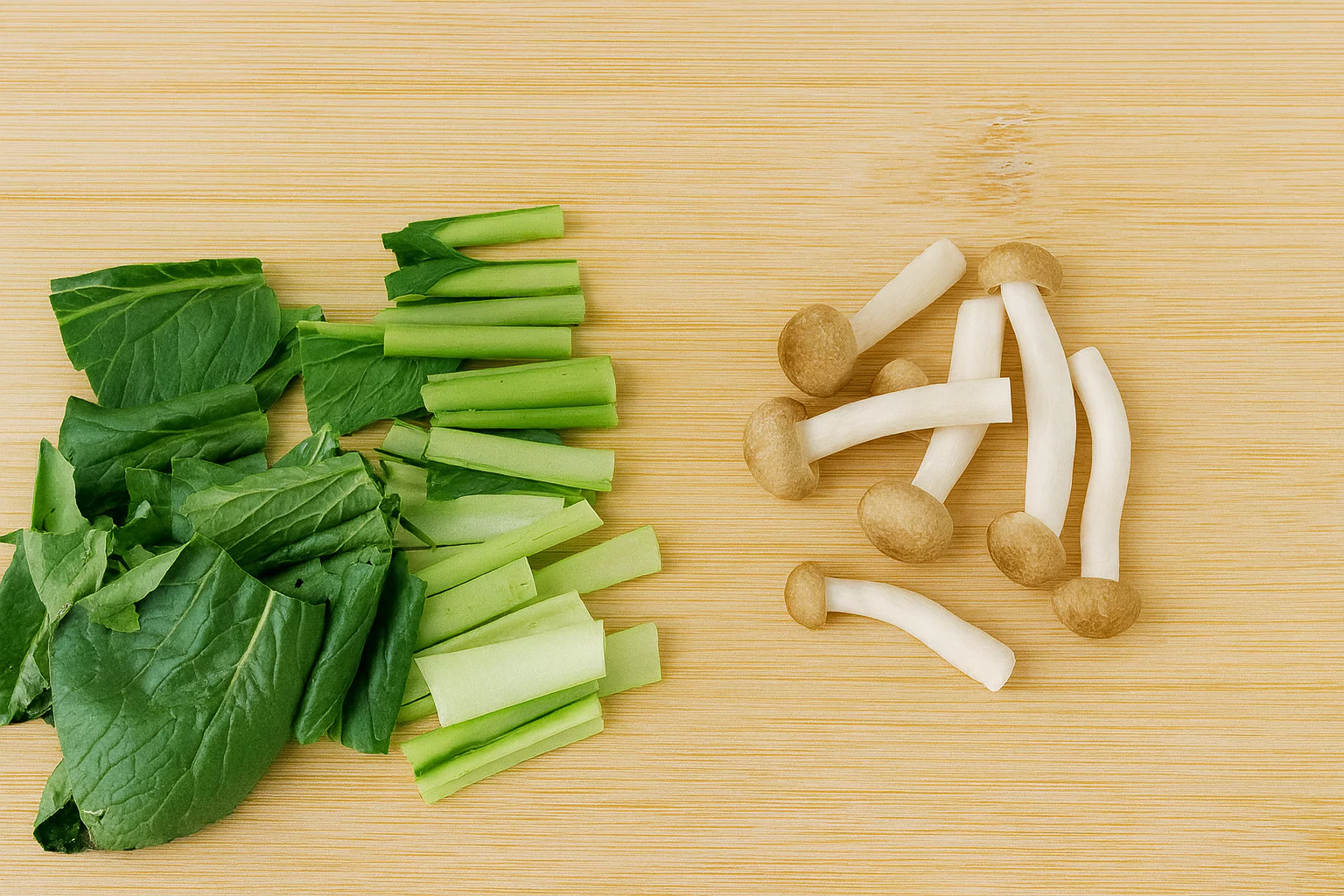
Step 2: Sauté the Vegetables
- Heat a teaspoon of salad oil in a pot over medium heat.
- Add the komatsuna, mushrooms, and ginger paste.
- Sauté for 2–3 minutes until the greens begin to soften and the mushrooms release their aroma.
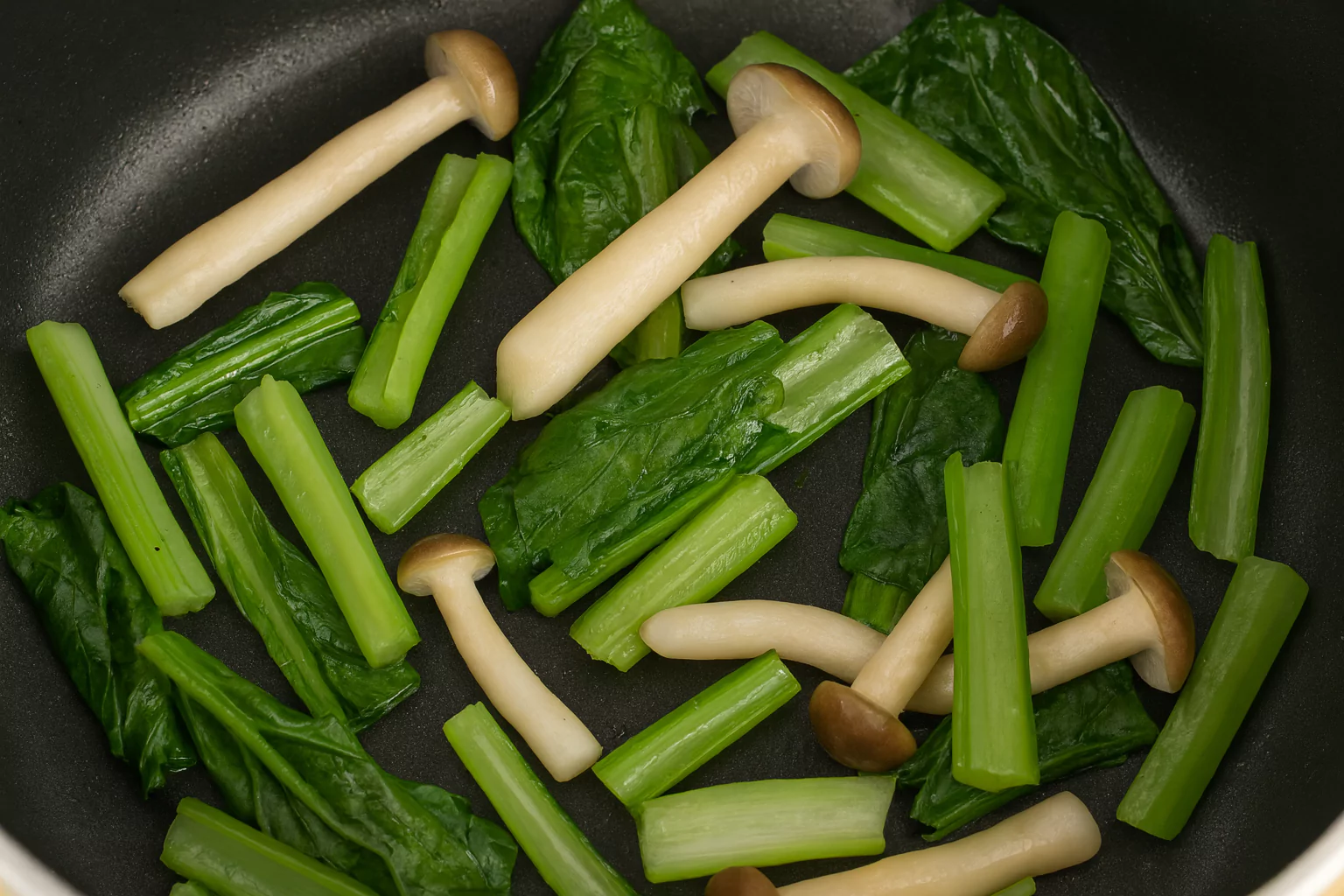
Step 3: Make the Broth
- Pour in 400 ml of water.
- Add 2 tablespoons of white dashi and a little pepper.
- Bring the mixture to a gentle boil.
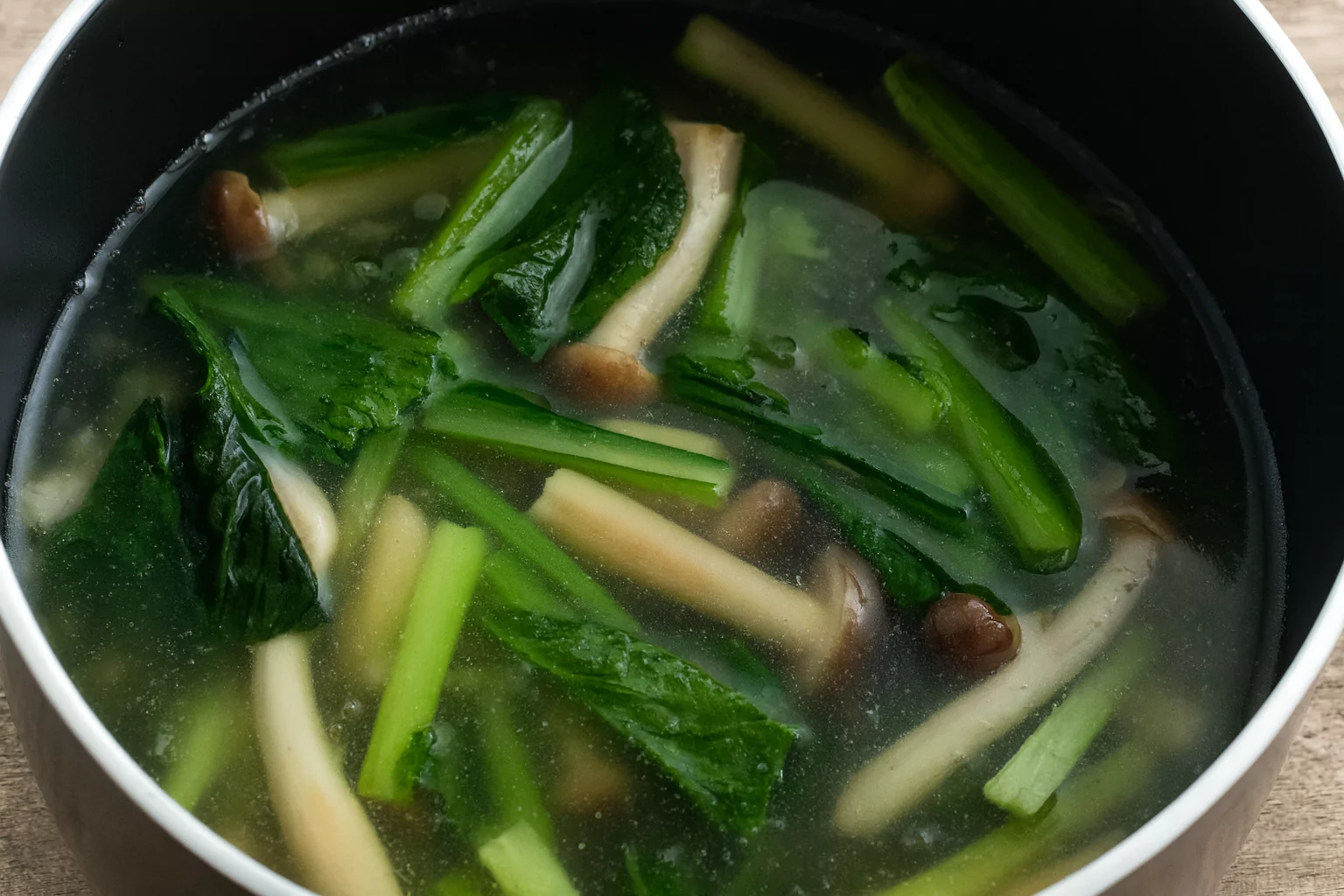
Step 4: Thicken the Soup
- Mix 2 teaspoons potato starch with 1 tablespoon water in a small dish.
- Turn off the heat and add this slurry to the pot. Stir well.
- Return the pot to heat and continue stirring until the soup slightly thickens.
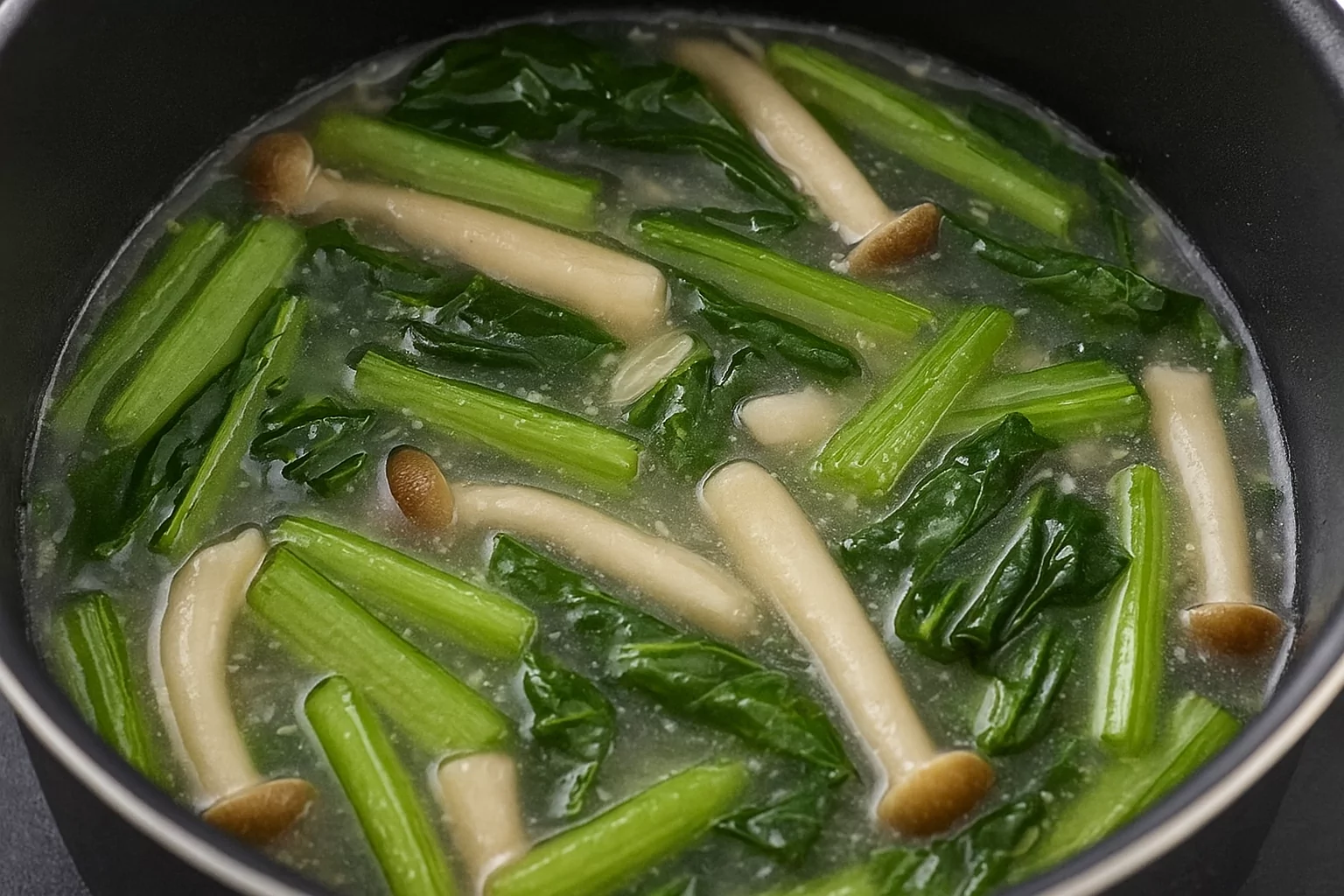
Step 5: Add the Egg
- Bring the soup back to a boil.
- Slowly pour in the beaten egg while stirring gently with chopsticks or a fork.
- The egg will form delicate ribbons and give the soup a silky texture.
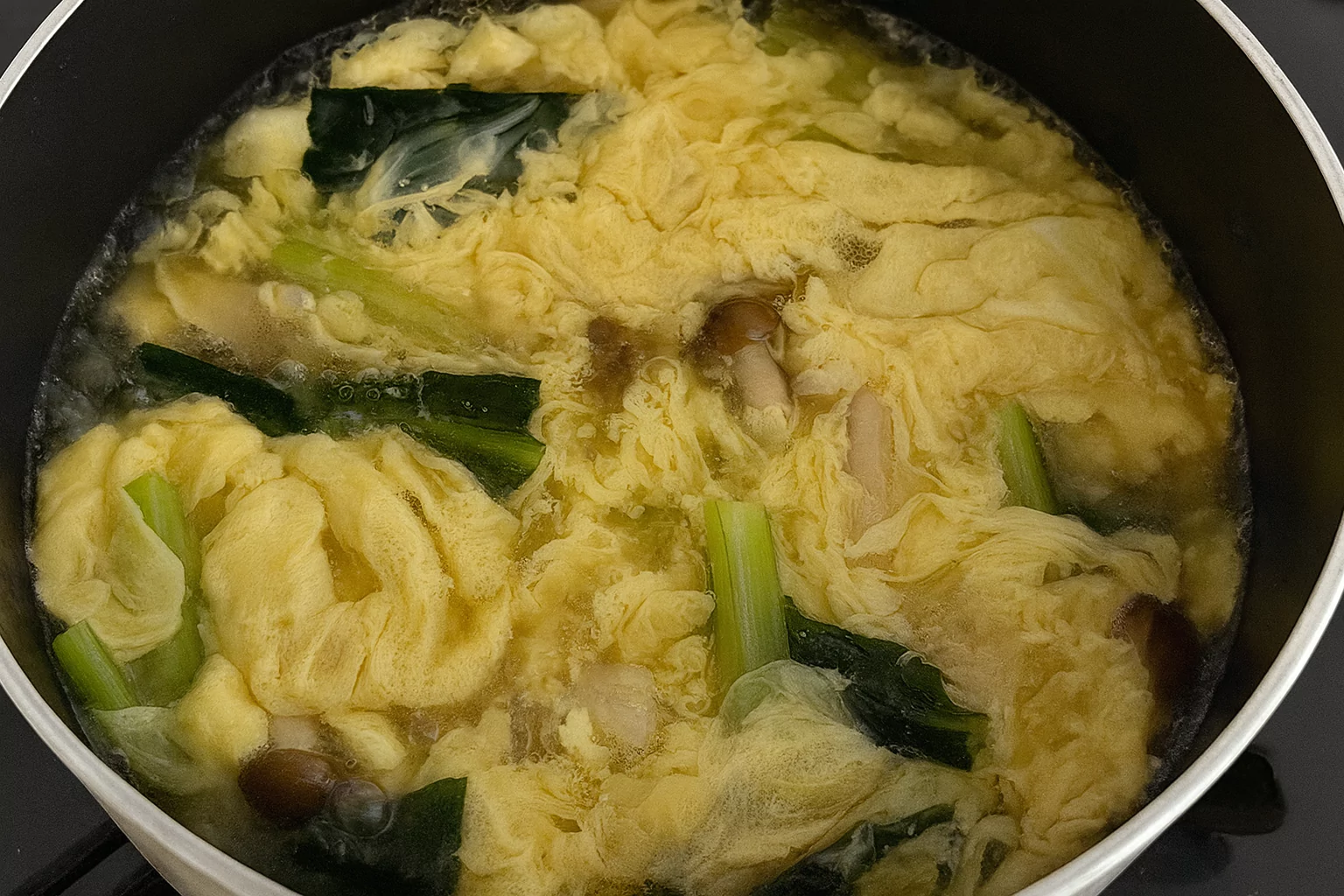
And that’s it! Your comforting bowl of Komatsuna soup (小松菜スープ) is ready to serve.
Secrets to Success and Expert Tips
- Do not overcook the komatsuna. It only needs a couple of minutes to become tender. Overcooking makes it lose color and nutrition.
- Add the potato starch off heat. If you add the slurry while boiling, it can clump. Turning off the heat first ensures smoothness.
- Egg technique matters. Pour slowly in a thin stream and stir lightly to make fluffy ribbons. If you stir too much, the egg becomes grainy.
- Taste and adjust. Some brands of white dashi are saltier than others, so adjust the seasoning at the end.
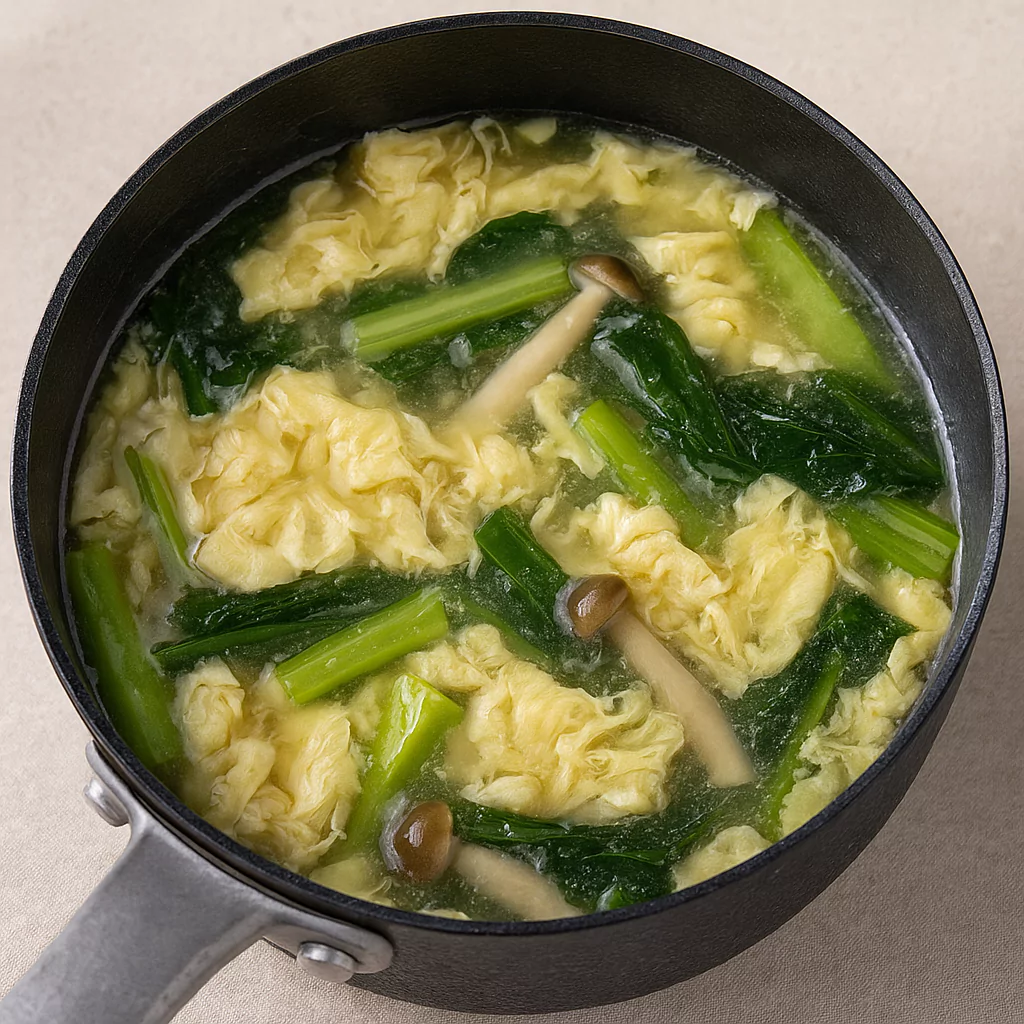
Assembly and Presentation
The beauty of this soup lies in its simplicity, but a few small touches can elevate it.
- Bowl choice: Use a deep Japanese soup bowl for an authentic feel.
- Garnishes: Add a sprinkle of chopped scallions, sesame seeds, or even a small sheet of nori for decoration.
- Serving: Serve it hot, as soon as it’s ready, to enjoy the full flavor of the ginger and greens.
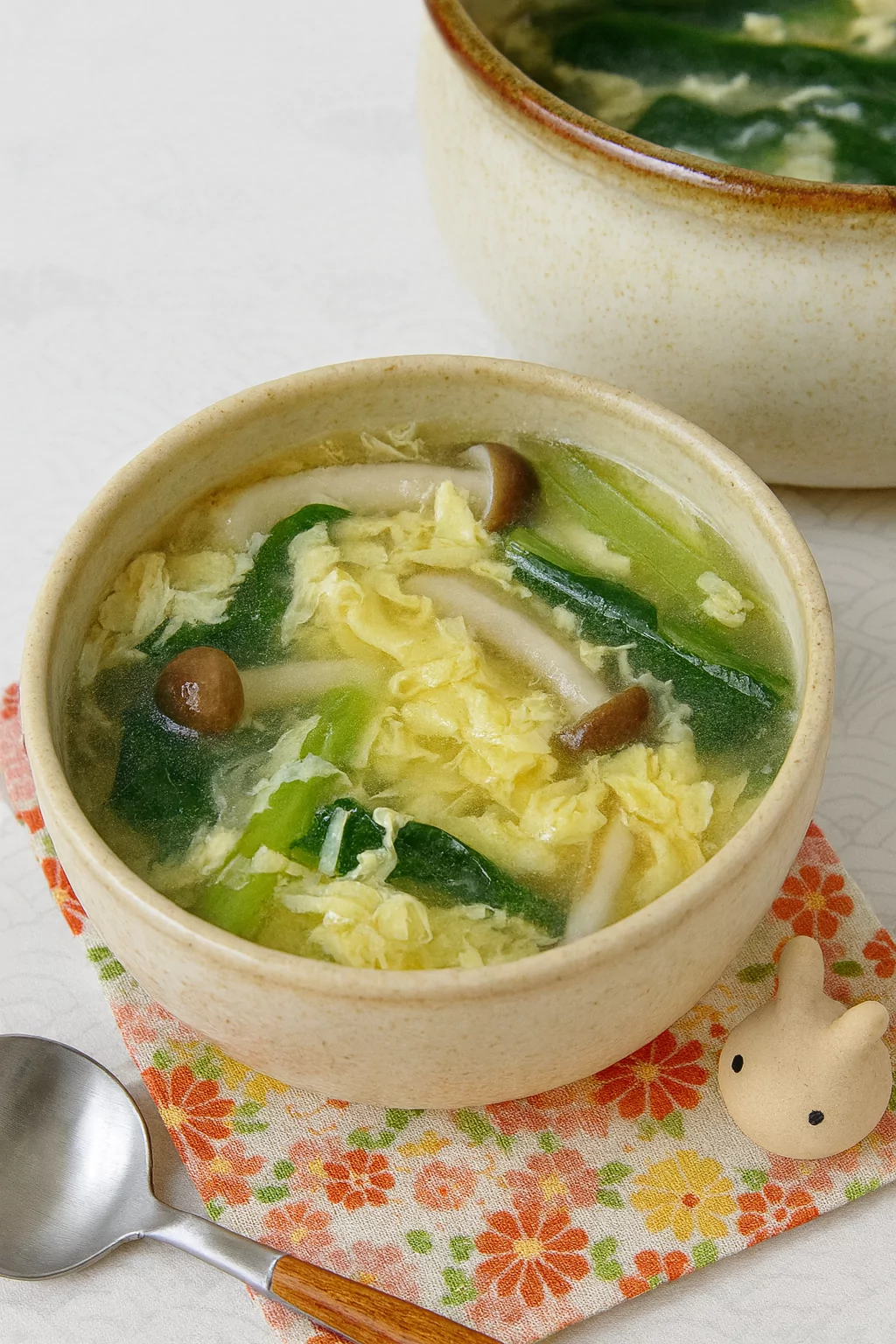
Komatsuna soup (小松菜スープ) @JapanDishes
Hana’s Recipe Tips
- If you want a lighter soup, skip the potato starch slurry and leave the broth clear.
- For a heartier meal, add thin udon noodles or rice at the bottom of the bowl before pouring the soup on top.
- This dish pairs wonderfully with grilled fish, rice, or a Japanese omelet for a balanced meal.
Storage and Make-Ahead Tips
- Refrigerator: Store leftovers in an airtight container for up to 2 days.
- Reheating: Warm gently on the stove. Avoid boiling too long, as the komatsuna may overcook.
- Make-ahead: You can prepare the broth (with mushrooms and seasoning) in advance and refrigerate it. When ready to serve, reheat and add the komatsuna and egg fresh. This keeps the greens vibrant and the egg fluffy.
Recipe Variations
One of the best things about Komatsuna soup (小松菜スープ) is its flexibility. Try these variations:
- Tofu Komatsuna Soup: Add silken tofu cubes for protein and creaminess.
- Seaweed Twist: Add dried wakame seaweed to the broth for extra umami.
- Spicy Version: Stir in a dash of chili oil or shichimi togarashi (Japanese seven-spice).
- Clear Soup Style: Skip the starch thickener for a lighter, clearer broth.
- Miso Blend: Stir in a teaspoon of miso paste at the end for a deeper, earthier flavor.
Health Benefits of Komatsuna Soup
Komatsuna is sometimes called the “Japanese super green.” Here’s why:
- Rich in vitamins A, C, and K for strong immunity and bone health.
- High in calcium—great for those who don’t consume much dairy.
- Low in calories but full of fiber, making it filling and light.
- Ginger aids digestion and circulation.
- Eggs and mushrooms add protein and minerals, creating a well-rounded dish.
This soup proves that you don’t need complex recipes to make something nourishing.
Other Japanese Soups to Try
If you enjoy Komatsuna soup (小松菜スープ), you may want to explore other comforting Japanese soups as well. Each one has its own special character and flavor profile:
- Tonjiru (豚汁) – Pork and Vegetable Miso Soup (Butajiru): A hearty, filling soup made with pork belly, root vegetables, and miso. It’s rich, warming, and perfect for cold weather.
- Japanese Egg Drop Soup (Kakitamajiru / かきたま汁): A lighter, delicate soup made with dashi broth and silky egg ribbons. It’s similar in spirit to Komatsuna soup, but with a clear broth and a softer, gentler taste.
These soups highlight how Japanese cooking can be both nourishing and simple, giving you new ideas for meals that are easy to prepare yet deeply satisfying.
Conclusion
So, can a simple soup really deliver warmth, health, and comfort in just a few minutes? The answer is yes—and Komatsuna soup (小松菜スープ) is the proof. With fresh greens, silky egg, and a light dashi broth, it’s the kind of dish you’ll want to make again and again. Whether you prepare it as a quick lunch, a side for dinner, or a comforting bowl when you’re under the weather, this recipe always works its magic. Don’t be afraid to experiment with substitutions and variations—once you master the base, the possibilities are endless.
If you love Japan, food, and exploring culture, you might also enjoy reading about kokeshi dolls and discovering more travel tips, Japanese news, and design inspiration. Check out this link: Kokeshi Dolls: 10 Unique Designs Collectors Love for a charming dive into Japanese folk art and culture.
FAQs
1. What does Komatsuna taste like?
Komatsuna has a mild, slightly peppery flavor, similar to a cross between spinach and mustard greens. In soup, it becomes tender and delicate.
2. Can I use spinach instead of komatsuna?
Yes! Spinach or bok choy are both excellent substitutes if komatsuna is hard to find.
3. Is this soup good for weight loss?
Yes. It’s low in calories but high in nutrients and fiber, making it filling without being heavy.
4. Can I make this soup vegetarian?
Definitely. Use a vegetarian dashi or vegetable broth instead of white dashi. Keep the egg or replace it with tofu.
5. How long does it take to cook?
The whole recipe takes about 15 minutes, including prep. It’s perfect for busy days.
6. Can I freeze Komatsuna soup?
Freezing is not recommended, as the greens and egg lose texture. It’s best enjoyed fresh or stored in the fridge for 1–2 days.
7. What can I serve with Komatsuna soup?
It goes well with rice, grilled fish, Japanese pickles, or a light salad. It’s also perfect on its own.
Komatsuna soup 小松菜スープ
Course: Main CoursesCuisine: JapaneseDifficulty: Easy2
servings5
minutes10
minutes~120
kcalIngredients
50 g komatsuna (about ¼ bag), cut into 3 cm pieces
½ pack shimeji mushrooms, trimmed and separated
4 cm ginger paste (from a tube) or freshly grated ginger
400 ml water
2 tablespoons white dashi
A pinch of pepper
2 teaspoons potato starch mixed with 1 tablespoon water (slurry)
1 egg, lightly beaten
1 teaspoon salad oil (for frying)
Directions
- Step 1 – Prep the ingredients
Wash the komatsuna and cut it into 3 cm lengths. Trim the root ends of the shimeji mushrooms and separate them. Beat the egg in a small bowl. - Step 2 – Sauté vegetables
Heat salad oil in a pot over medium heat. Add the komatsuna, mushrooms, and ginger paste. Stir-fry for about 2–3 minutes until softened. - Step 3 – Create the broth
Add water, white dashi, and a pinch of pepper to the pot. Bring to a gentle boil. - Step 4 – Thicken the soup
Turn off the heat. Stir in the potato starch and water slurry. Return to heat and stir until slightly thickened. - Step 5 – Add the egg
Bring the soup back to a gentle boil. Slowly pour in the beaten egg while stirring lightly with chopsticks to create fluffy ribbons. - Step 6 – Serve
Ladle into bowls and enjoy hot. Optionally garnish with scallions, sesame seeds, or nori strips.
Notes
- ✪ Don’t overcook the komatsuna—its bright green color and nutrition are best preserved when cooked quickly.
✪ For a lighter version, skip the potato starch slurry and enjoy it as a clear broth.
✪ You can replace komatsuna with spinach or bok choy if it’s hard to find.
✪ This soup pairs well with rice, grilled fish, or pickled vegetables for a balanced meal.
